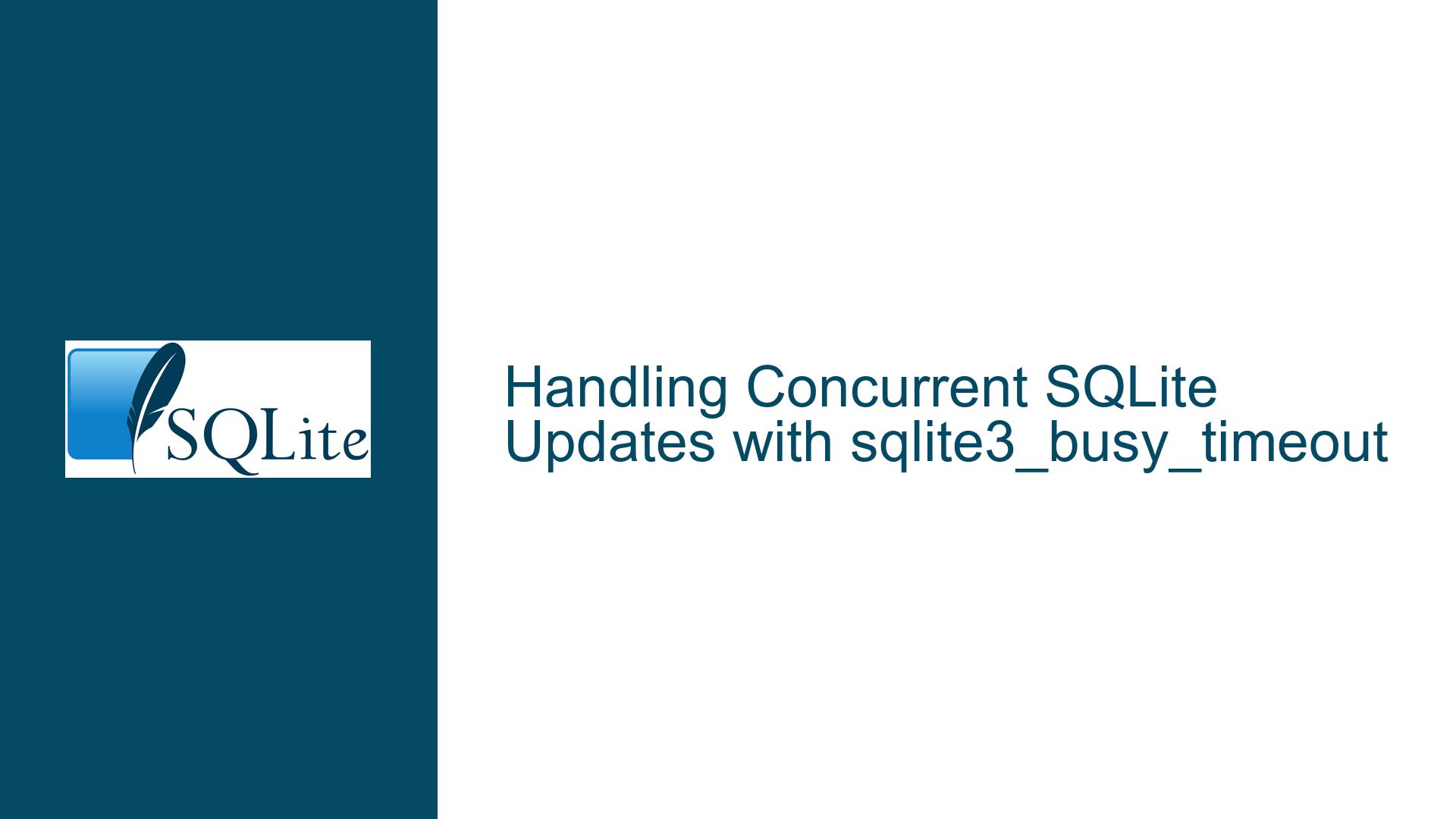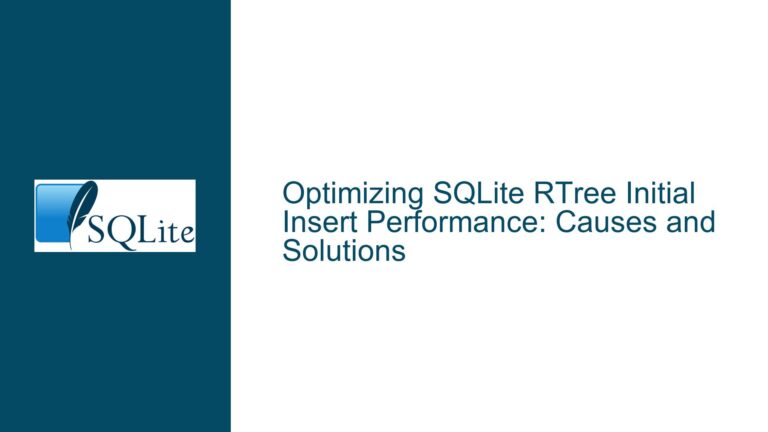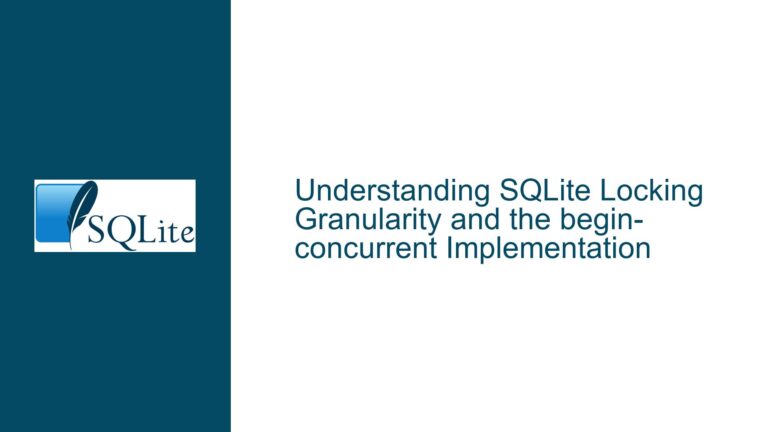Handling Concurrent SQLite Updates with sqlite3_busy_timeout
Concurrent Update Failures in SQLite Due to Busy Events
When multiple users attempt to update the same SQLite database simultaneously, the database can become locked, leading to update failures. This issue is particularly prevalent in environments where the database is accessed by multiple clients or threads without proper concurrency control mechanisms. In the provided scenario, the UPDATE statement fails when two users try to update the same record at the same time, resulting in no changes being committed to the database. This behavior is a direct consequence of SQLite’s default locking mechanism, which locks the entire database during write operations to maintain data integrity.
SQLite employs a file-based locking system to manage concurrent access. When a write operation is initiated, SQLite acquires a reserved lock, which prevents other write operations from proceeding until the current operation is complete. If a second write operation is attempted while the first is still in progress, SQLite will return a SQLITE_BUSY error. This error indicates that the database is temporarily unavailable for writing. Without proper handling, this can lead to update failures, as seen in the scenario.
The sqlite3_busy_timeout function is designed to mitigate this issue by introducing a delay before returning the SQLITE_BUSY error. This delay allows the database to become available for writing, reducing the likelihood of update failures. However, implementing sqlite3_busy_timeout requires careful consideration of the application’s concurrency requirements and the potential impact on performance.
Interrupted Write Operations Leading to Update Failures
The primary cause of the update failures in this scenario is the lack of proper handling of concurrent write operations. SQLite’s default behavior is to lock the database during write operations, which can lead to conflicts when multiple users attempt to update the same record simultaneously. This issue is exacerbated by the absence of a busy timeout mechanism, which would otherwise allow the database to wait for a specified period before returning a SQLITE_BUSY error.
In the provided code, the UPDATE statement is executed without any concurrency control measures, making it susceptible to conflicts. When two users attempt to update the same record at the same time, the first user’s write operation locks the database, preventing the second user’s write operation from proceeding. Since the second operation does not wait for the lock to be released, it fails immediately, resulting in no changes being committed to the database.
Another contributing factor is the use of explicit transaction management. The code includes a TransactionUnlock method, which suggests that the application is manually managing transactions. While manual transaction management can provide greater control over database operations, it also increases the risk of concurrency issues if not implemented correctly. In this case, the lack of a busy timeout mechanism means that the application does not wait for the lock to be released, leading to update failures.
Additionally, the code does not handle exceptions effectively. The catch block is empty, which means that any errors, including SQLITE_BUSY errors, are silently ignored. This makes it difficult to diagnose and resolve concurrency issues, as there is no feedback when an update fails.
Implementing sqlite3_busy_timeout and Proper Exception Handling
To address the issue of concurrent update failures, it is essential to implement a busy timeout mechanism and improve exception handling. The sqlite3_busy_timeout function can be used to introduce a delay before returning a SQLITE_BUSY error, allowing the database to become available for writing. This can be achieved by setting the busy timeout value in the SQLite connection string or by calling the sqlite3_busy_timeout function directly.
In the provided code, the SQLiteConnection object is used to establish a connection to the database. To set the busy timeout, the BusyTimeout property of the SQLiteConnection object can be used. This property specifies the maximum amount of time, in milliseconds, that the connection should wait for the database to become available before returning a SQLITE_BUSY error. For example, setting BusyTimeout to 5000 would cause the connection to wait for up to 5 seconds before returning an error.
using (SQLiteConnection m_dbConnection = new SQLiteConnection(ConnString))
{
m_dbConnection.BusyTimeout = 5000; // Set busy timeout to 5 seconds
m_dbConnection.Open();
// Execute the update statement
}
In addition to setting the busy timeout, it is important to handle exceptions effectively. The catch block should be modified to log or display any errors that occur during the update operation. This will make it easier to diagnose and resolve concurrency issues. For example:
catch (SQLiteException ex)
{
// Log or display the error message
Console.WriteLine("An error occurred: " + ex.Message);
}
Furthermore, the use of explicit transaction management should be reviewed. If the application is manually managing transactions, it is important to ensure that the transactions are properly committed or rolled back in the event of an error. This can be achieved by using a try-catch-finally block to handle the transaction lifecycle. For example:
try
{
m_dbConnection.Open();
using (SQLiteTransaction transaction = m_dbConnection.BeginTransaction())
{
try
{
// Execute the update statement
cmd.ExecuteNonQuery();
transaction.Commit();
}
catch (SQLiteException ex)
{
transaction.Rollback();
// Log or display the error message
Console.WriteLine("An error occurred: " + ex.Message);
}
}
}
finally
{
m_dbConnection.Close();
}
By implementing a busy timeout mechanism and improving exception handling, the application can better handle concurrent update operations, reducing the likelihood of update failures. Additionally, proper transaction management ensures that the database remains in a consistent state, even in the event of an error.
Optimizing SQLite Performance for Concurrent Updates
In addition to implementing a busy timeout mechanism and improving exception handling, there are several other strategies that can be employed to optimize SQLite performance for concurrent updates. These strategies include using the WAL (Write-Ahead Logging) journal mode, optimizing the database schema, and using connection pooling.
The WAL journal mode is a powerful feature of SQLite that can significantly improve performance in concurrent environments. Unlike the default DELETE journal mode, which locks the entire database during write operations, the WAL mode allows multiple readers and a single writer to access the database simultaneously. This can greatly reduce the likelihood of conflicts and improve overall performance. To enable the WAL mode, the following SQL command can be executed:
PRAGMA journal_mode=WAL;
This command should be executed once when the database is created or opened. Once the WAL mode is enabled, the database will use a write-ahead log to record changes, allowing readers to continue accessing the database while write operations are in progress.
Optimizing the database schema can also improve performance in concurrent environments. This includes using appropriate indexes, avoiding unnecessary columns, and normalizing the database schema. Indexes can speed up query performance by allowing the database to quickly locate the rows that match a given condition. However, indexes also introduce overhead during write operations, so it is important to strike a balance between read and write performance.
Connection pooling is another strategy that can improve performance in concurrent environments. Connection pooling allows multiple database connections to be reused, reducing the overhead of establishing and closing connections. This can be particularly beneficial in applications that perform a large number of short-lived database operations. Many SQLite libraries, including the System.Data.SQLite library used in the provided code, support connection pooling out of the box.
By combining these strategies with a busy timeout mechanism and proper exception handling, it is possible to significantly improve the performance and reliability of SQLite in concurrent environments. This will ensure that the database can handle multiple update operations simultaneously, without compromising data integrity or performance.
Conclusion
Handling concurrent updates in SQLite requires a combination of proper concurrency control mechanisms, effective exception handling, and performance optimization strategies. By implementing a busy timeout mechanism, improving exception handling, and optimizing the database schema and connection management, it is possible to significantly reduce the likelihood of update failures and improve overall performance. The WAL journal mode, in particular, is a powerful tool that can greatly enhance SQLite’s ability to handle concurrent updates, making it an essential consideration for any application that requires high levels of concurrency.
In summary, the key to handling concurrent updates in SQLite lies in understanding the underlying causes of update failures and implementing the appropriate measures to mitigate them. By following the strategies outlined in this guide, developers can ensure that their SQLite databases remain reliable and performant, even in the face of high levels of concurrent access.






